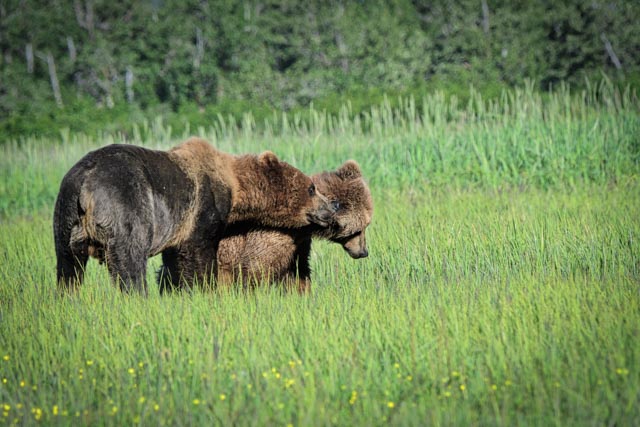I recently returned from a photography trip to the Katmai National Park and Wilderness Preserve in southern Alaska. Katmai was declared a national monument in 1918 and designated a National Park in 1980. In the summer brown bears gather at streams to feast on salmon and fatten up on the sedge grass.

We started our trip with a seaplane flight from Kodiak across the Shelikof Strait landing in Kukak Bay to board the Natural Habitat’s Ursus. The Ursus is a converted Crab ship from the Bering Sea and had a starring role on Discovery’s Dangerous Catch as the original Time Bandit. We landed on a beautiful sunny day on Kukak bay on of the coastal inlets along the Katmai peninsula. The is a ridge of volcanic peaks forms by the coalition of the Pacific and North American plates.
The last major eruption in historical times was the simultaneous eruption of Mount Katmai and Novarupta in June 1912. Novarupta’s eruption produced a pyroclastic flow that covered a nearby valley with ash as much as 300 feet (91 m) thick. At the same time the summit of Katmai collapsed into a caldera. As the valley deposits cooled, they emitted steam from fissures and fumaroles, earning the name “Valley of Ten Thousand Smokes.”

Katmai is the home for brown bear is one of the most omnivorous animals in the world and has been recorded consuming the greatest variety of foods of any bear.[85] Certainly no other animal in their given ecosystems, short perhaps of other bear species and humans, can claim to feed on as broad a range of dietary opportunities. Food that is both abundant and easily obtained is preferred. Their jaw structure has evolved to fit their dietary habits. Their diet varies enormously throughout their differing areas based on opportunity.[7][246] In July, we saw bears eating a lot of grasses, shoots, sedges and forbs. They were like lawnmowers or bison working their way through the sedge. In other areas fruits, including berries, become increasingly important during summer and early autumn. They also hunt for clams along the beaches of the Katmai coast.
Brown Bear Cubs
The newborn cubs are born after a relatively short gestation allow the mothers are hibernating only weighing about a pound at birth and nurse from their sleeping mother until they emerge in the spring. The female is solely responsible for raising the cubs and they remain with her for about 3-4 years.


Kukak Bay in Katmai National Park

Summer is also the time for new lover and procreation. Female bears go into estrus after they have separated from their cubs and are receptive to the males. Large boars will fight over the rights to mate and the fights can be very brutal until one give up the right to mate. The females delay the implantation of the embryo until the winter and if she has not gained enough weight it may not occur at all.

Katmai is also home to a large number of sea birds and other migratory birds. One of the most colorful is the Puffins.

These colorful sea birds make their nest in the soil at the top of rocky cliffs. Both the female and male incubate the single egg that is laid and feed the newborn chick born after an incubation of 45 days. After fledging the young puffins spend the next few years at sea until they are ready to breed. The puffins are not great flyers but their short compact bodies are excellent for diving for fish.